Reading Room Search
Go here for complete Reading Room Article Index
Displaying 176 - 200 of 607Catholic Church's Challenge: Critical Consciousness
Popes and bishops call for media literacy principles to be taught at all levels. The Catholic Church has spoken about the power of media since the invention of the motion picture. Its concern has always been a call for critical consciousness, an understanding of the media's role and place in modern culture, and creative collaboration between the faithful and the media.
In 1971 Communio et Progressio: the Pastoral Instruction from the Second Vatican Council on the Means of Social Communications issued the challenge:
"The Church considers it to be one of her most important tasks to provide the means for educating recipients of the media in Christian principles. Catholic... Read More
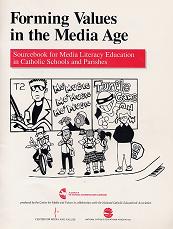
We live in the information age. It's said often, but what does it mean? Let's examine it. The amount of information in the world doubles every five years.1 Imagine, every five years the world's information doubles!
But there's more to the information explosion than that. Consider this: there is more information in the daily edition of The New York Times than an individual man or woman in the 16th Century had to process in their whole lives. More information in a daily newspaper than in a lifetime!
And that doesn't include all the information we have to process from other sources: television... Read More
Who Tells the Stories?: Catholic Media Literacy Curriculum Published
Multimedia program to be used in schools and parishes nationwide
LOS ANGELES, CA, September, 1993 — Reclaiming the story-telling and value-assigning roles that media, especially television, have taken over from families, schools and religion is the goal of a unique media literacy project developed this fall by The Catholic Communication Campaign for use in Catholic classrooms, parishes and homes.
The new multimedia learning program, called Catholic Connections to Media Literacy, was developed to answer the urgent need for a new educational approach to the issues of mass media in society today.
"Media literacy helps us decode the data," said Sister... Read More
Looking at this audience full of my friends and of supporters of the Center, and I feel very humble. And grateful to be here with you, and to know that you are here because you want to see the Center succeed with our very important mission of spreading the message of media literacy.
I've become impassioned about that mission, to the point where my children are saying, "Oh Mom! All you can think about is media literacy!" And my friends are rolling their eyes. So in reflecting about what to share with you today, I decided to step back and ask myself, "Why is media literacy so important to me?... Read More
Aspen Institute Report of the National Leadership Conference on Media Literacy
1992 gathering puts media literacy on U.S. educational agenda. As the movement for media literacy education emerged in the US in the early 1990s, there were many questions and opinions about what media literacy was all about. For the most part, media education activities were limited to grassroots efforts — an innovative teacher here, a pioneering school district there; some efforts were concerned about issues, like violence in the media or tobacco advertising; others were focused on skills, like video production and enabling young people to produce their own media.
So a landmark event in the history of media literacy in the USA was the... Read More

While the outcry over muzzling the news media and thus controlling public information reached a fever pitch recently with [fill in name of war, political scandal or international incident] keeping reporters and cameras away from the action started long ago — even with television's predecessor, the newsreel.
Although their flickering pictures represented one view of reality for several generations of Americans, newsreels basically ignored some of the most important events of their day. Many shots of Pearl Harbor, for example, were not shown until a year after the Sunday morning attack. And... Read More
Learning for the 21st Century
A Report and Mile Guide for 21st Century Skills Published by the Partnership for 21st Century Skills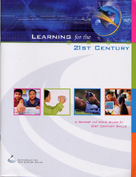
"A simple question to ask is, 'How has the world of a child changed in the last 150 years?" And the answer is, "It's hard to imagine any way in which it hasn't changed! But if you look at school today versus 100 years ago, it is more similar than dissimilar."
— Peter Senge, senior lecturer Massachusetts Institute of Technology
How do we best prepare our young people to succeed in the 21st century? As a comprehensive effort to identify the essential skills that people need today — and tomorrow — the Learning for the 21st Century report articulates a compelling vision for education in the... Read More
The Bribed Soul: Ads, TV and American Culture
How advertising transforms both our experience and identity into a "sponsored life." By Leslie Savan
Television-watching Americans — that is, just about all Americans — see approximately 100 TV commercials a day. In that same 24 hours they also see a host of print ads, billboard signs, and other corporate messages slapped onto every available surface, from the fuselages of NASA rockets right down to the bottom of golf holes and the inside doors of restroom stalls. Studies estimate that, counting all the logos, labels and announcements, some 16,000 ads flicker across an individual's consciousness daily.
Advertising now infects just about every organ of society, and wherever advertising gains... Read More
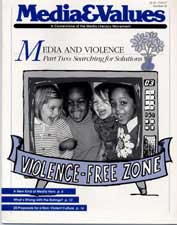
EDITOR'S NOTE: With the growth of the Internet and e-mail, this postcard campaign may seem outdated. But the basic principles here are timeless and with e-mail, it's even easier to organize a campaign to express your point of view.
On January
l5, l993, Mary Beth Boesen went to enjoy Denver's annual
celebration for Dr. Martin Luther King, one of the U.S.'
great non-violent heroes. "It was a beautiful day,"
Boesen recalls. "There were speeches and a huge birthday
cake. Lots of people turned up, old and young, people of... Read More
Is the relationship between media and societal violence a function of the quantity of the images or the way the violence is presented?
A 1981 study comparing Japanese and American television found major differences in the way violence is portrayed on screen between the two countries. One of the major findings was that the amount of violence on Japanese and American television is roughly the same. The nature of the Japanese television violence, however, is different. Violent scenes are less frequent in Japanese-produced programs, yet tend to last longer, are more realistic and place a... Read More
The relationship between screen violence and street violence has been studied ever since the early days of television - some say over 3,000 studies in the past four decades. While it is too simplistic (and impossible) to "prove" that media portrayals "cause" violence in real life, there are more nuanced studies that explore how media violence is perceived by viewers or internalized in attitudes and/or behaviors.
In one interesting study, social science researchers Daniel Linz, Barbara J. Wilson and Barbara Randall first identified six different and distinct characteristics of "violence" in... Read More
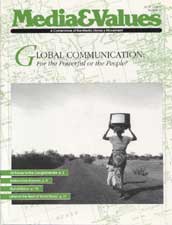
Development and reform of global communications have been a continuing focus of mainline Protestant groups worldwide over the last 20 years. Led by the World Association for Christian Communication (WACC), a values-based international communication and development organization, the issue has been discussed at WACC-sponsored international conferences in the Caribbean, the Philippines, France, Brazil and elsewhere. The National Council of Churches of Christ in the U.S.A. (NCCC) drafted Global Communication for Justice and Peace, the policy statement that appears below, following a summary... Read More
Meeting Media in Every Corner of Our Lives
One man's reflection on why media literacy is important. By Bruce Campbell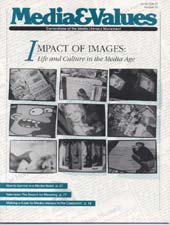
I was a high school student when William Freidkin's The Exorcist found its way to theaters in my Midwest hometown. In light of what has hit the screens since, the movie's special effects and horror techniques are almost quaint; but at the time the film (and the hype surrounding it) packed quite a punch.
My friends and I became completely absorbed in the phenomena that grew up around its opening. We were fascinated by the stories that people were becoming sick in screenings. Some of us plotted to attend, somehow (since we were under the age of the R rating); others piously turned away. A... Read More
Gulf War: The More We Watched, the Less We Knew
Despite wall to wall coverage of 'Desert Storm', viewers don't get the big picture. By Rosalind Silver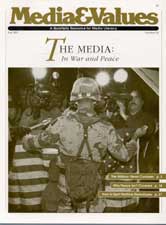
What would happen if they held a war and nobody watched?
As Media&Values staff members joined the millions of TV watchers glued to their television sets in January, we began asking ourselves that question. As the hours of televised bombardments, Scud missile attacks and, ultimately, victory parades wound on, we became more and more aware of the media's role in forming not just issues of war and peace, but our view of them.
In fact, according to the responses of selected Denver residents to a poll conducted by University of Massachusetts/Amherst researchers, media usage played a big role... Read More

On April 12 1989, ABC aired a shocking episode of its popular sitcom, Growing Pains. A close friend of the show's teenaged lead characters was seriously injured in a drunk driving crash, after having "just a few drinks." Hospitalized with his injuries, the youngster vowed to change his ways, grateful for his "second chance." Then, in a dramatic twist, the teenager suddenly died. As Daily Variety explained, the show's producers had decided to sacrifice the character to "break the typical sense of denial by young people that they're anything but immortal."
The "Second Chance" episode of Growing... Read More
Five Important Ideas To Teach Your Kids About TV
Everyone tells you to talk with your kids about TV. Here's one father's thoughts about what to say. By J. Francis Davis
You've probably heard that, as a modern-day parent, you should be watching TV with your kids and discussing what they see and hear. A recent statement from the American Academy of Pediatrics, for example, states "Parents should watch television with their children in order to help interpret what they see." In fact, just about everyone who gives advice about children and TV these days is saying, "Discuss television with your children!" If you're like me, however, this kind of advice only causes you to breathe in through clenched teeth.
Not that I disagree. I mean, it's a good idea to... Read More
When Kids are Watching: Confessions of a SitCom Producer
The creator of Family Ties reflects on who's in the audience By Gary David Goldberg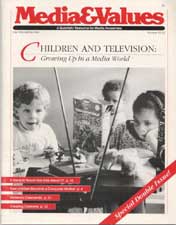
The insidious thing about television's invasion of the home is not the message of its programs, but the audience that is watching. The sobering reality a prime-time television producer must face is that eight- and 10-year-old children are left alone to watch TV by themselves. How do children, lacking in mature judgment, process what they see? How do they tell good from bad, truth from fiction, fantasy from reality? Without parents to guide their interpretations of the wild onslaught of information flowing out of that wonderful yet menacing box, what is presented on TV becomes the primary... Read More
Re-Touching Reality: Can Pictures Lie?
New technologies shake old beliefs in news photography by Bennett Daviss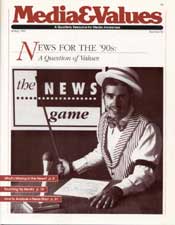
In 1982, the respected National Geographic attracted controversy by moving one of Egypt's great pyramids.
Through the magic of computer-generated digital imaging, the pyramid moved, not in space, but on the Geographic's cover, where its apex was electronically shifted to make it into the magazine's yellow cover frame.
"The effect was the same as if the photographer had moved over a few feet," the Geographic's editor Wilbur Garrett wrote to a complaining reader after the New York Times reported the magazine... Read More

Everyone has seen blatantly offensive advertisements that portray women
as sexual toys or victims of violence. Such irresponsible advertising has
rightly touched off cries of protest and organized action. The following
are some of the more subtle ways advertising reinforces cultural values
of subservience, domination and inequality between the sexes.
Superiority.Three common tactics used to establish
superiority are size, attention and positioning. Notice how
both men and women in the Hanes ad appear subservient because... Read More

"You're a Halston woman from the very beginning," the advertisement proclaims. The model stares provocatively at the viewer, her long blonde hair waving around her face, her bare chest partially covered by two curved bottles that give the illusion of breasts and a cleavage.
The average American is accustomed to blue-eyed blondes seductively touting a variety of products. In this case, however, the blonde is about five years old.
Advertising is an over 100 billion dollar a year industry and affects... Read More

"No Ken, I don't want to go to a movie later, 'cuz I need ta work out first.""OK, I'll be by in the vroom-vroom Ferrari to pick you up later."
—Five year-olds playing with a Barbie doll
"Yes, dear, try to get home, soon. The baby's sick and we need to take care of him."
—Mrs. Heart talking to Mr. Heart
"Out of my way. I'm She-Ra, princess of power. You can't stop me."
—Six year old assuming the identity of her doll
Once upon a time, every little girl was a Mrs. Heart. The dolls she dressed, fed and loved were her children. Her... Read More

Ultimately, the issue of sex in the media is not only one of personal morality but also one of ethics in a capitalistic society. The consumer economy is designed to maximize profits. And sex sells. So as long as we have 'marketplace forces' dominating the media industry (thanks to deregulation), we're going to have sex, and lots of it, in our entertainment media.
Some will want to protest the increasing amount of sex in media by boycotts or recommending that television be turned off. The problem is that with millions of viewers, a boycott by thousands does not make much of an impact overall.... Read More
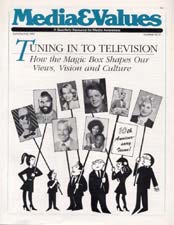
Media&Values is more than a magazine. It's a tool, a catalyst, for leading you — or helping you to lead others — from awareness to action on the many issues raised by today's mass media and new technology.
Whether you're a teacher, counselor, youth worker, religious leader or just an active media watcher of any age, the ideas and activities on the in each issue can help you examine your media environment and "make the connections" between what we hear, read and watch and our everyday lives.
Many people ask if anything can really be done about issues like sexual violence in the media,... Read More

Editor's Note: Although this exercise was created in the late 1980s when VCRs first came on the market, it's an exercise that can be applied to any emerging consumer technology — the Internet, DVD players, cell phones, wide-screen "entertainment centers;" there's always something new that can be the topic of this reflection/action exercise.
The videotape recorder has become almost as common place in our lives now as the television set. The following questions provide an opportunity to help families become aware of how it has influenced their family media habits. It's also a model exercise... Read More

